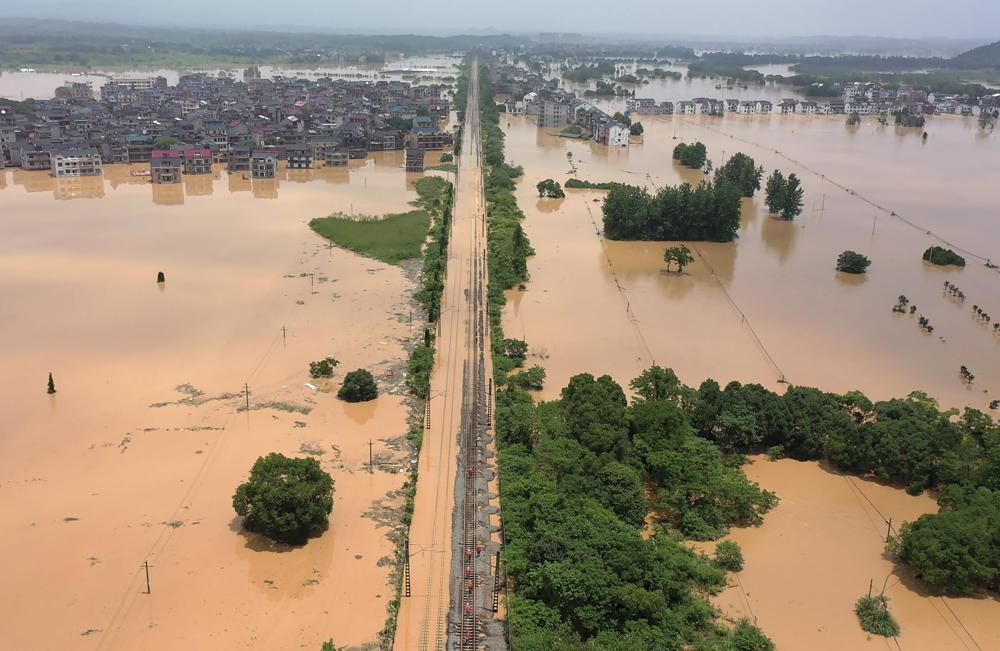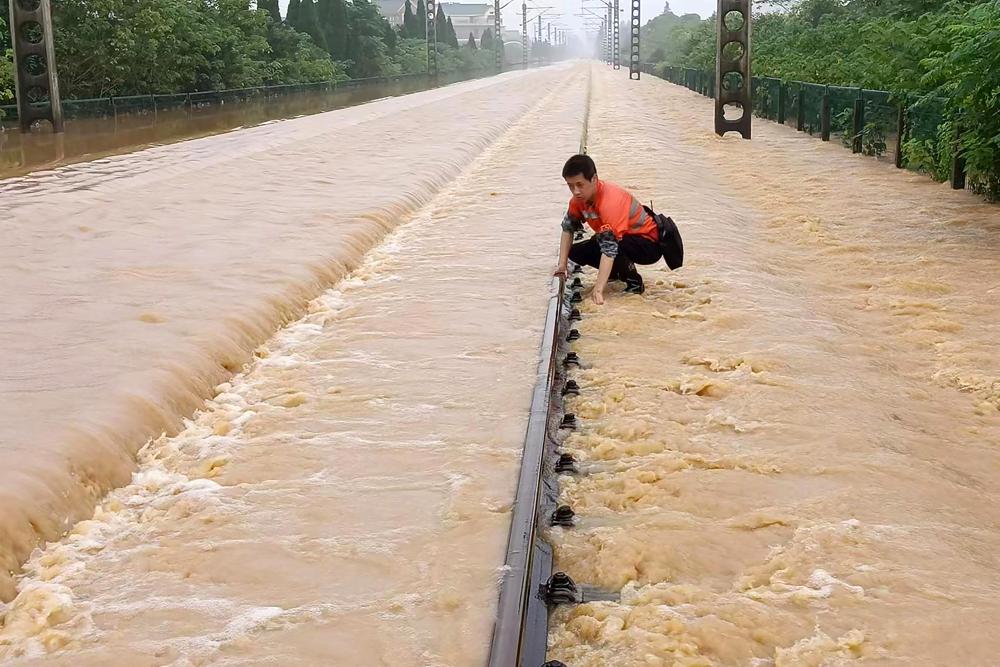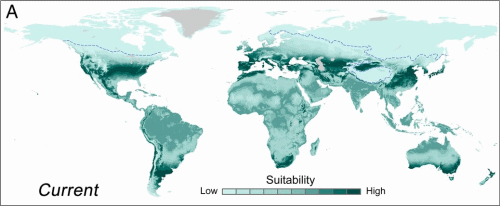Mass evacuations as record rain, floods strike southern China – Pearl River water level hits 100-year high – Heatwave causes record power demand surge in northern cities

By Jack Lau
20 June 2022
(SCMP) – Floodwaters engulfed homes, fields and roads in southern China as authorities evacuated nearly 150,000 residents after weeks of record rain.
A task force from Beijing was sent to Guangxi Zhuang autonomous region and Guangdong province to lead rescue and evacuation efforts on Monday, state broadcaster CCTV reported.
The China Meteorological Administration said the average rainfall for the May to June period in Guangxi, Guangdong and Fujian province reached a 61-year high.
Cars were washed down major roads by fast-flowing muddy waters while sewage overflowed in Nandan county in Guangxi, according to newspaper Nanguo Today.
In Wuzhou, social media live-streams by some of the city’s 2.8 million residents showed floodwaters blocking underground passageways and the Xi River, a tributary of the Pearl River, swollen.
Authorities closed floodgates upstream on the Xi River to reduce the impact of the waters.
The Ministry of Water Resources said water levels in Wuzhou might reach 5.5 metres (18 feet) above warning levels on Thursday if reservoirs were not used to ease water flows. [more]
Mass evacuations as record rain, floods strike southern China
China Hit by Floods and Heat Waves in Double Whammy
20 June 2022 (Bloomberg News) – Record rains in China’s southern provinces have forced millions of people to relocate even as the country’s north experiences abnormally high temperatures, showing the dual impacts of climate change in the world’s second-biggest economy.
From May 1 to June 15, the average precipitation in Fujian, Guangdong and Guangxi reached 621 millimeters, the highest recorded in six decades, the official Xinhua News Agency reported. Floods occurred along 117 rivers in the Pearl River Basin during the same period. The manufacturing hub of Guangzhou saw its highest tide in a century last week, with waters exceeding 2.6 meters (8.5 feet).
Floods are a regular occurrence in China during the summer, especially in the low-lying areas along the Yangtze River and its tributaries. But they are set to become more extreme and frequent as the planet warms, according to China’s latest Blue Book on Climate Change.
Local authorities in provinces including Zhejiang, Guangxi, Jiangxi and Hubei on Monday issued at least 14 red rainstorm alerts — the most severe level. China’s National Climate Center forecasts that flooding this year will be “relatively worse” and “more extreme” compared with historical levels.

Meanwhile heat waves are striking the northern and central provinces with some regions experiencing average temperatures of 40 degrees Celsius (104 Fahrenheit) for days. Thermometers in almost half of all cities in Henan province, which is home to nearly 100 million people, reached 40C last Thursday. More than 90 monitoring stations in the province recorded ground temperatures — which can be much higher because of concrete and asphalt pavements — that exceeded 60C. Eight stations saw 70C on the same day.
“Against the backdrop of climate change, the environments in which extreme weather events are happening are all changing to a different degree,” China Meteorological Administration spokesman Wang Zhihua said last summer after deadly floods that killed hundreds. “The new climate norm means that current record-setting events will become something that happens frequently.”
China Hit by Floods and Heat Waves in Double Whammy
What is causing record floods and heatwaves in China?
24 June 2022 (AFP) – Authorities have issued extreme weather warnings in multiple regions, while experts warned that these phenomena were more evidence of the impact of climate change.
How bad are the floods?
Summer floods are common in China, especially in the low-lying Pearl River delta region in the south.
This year, however, the National Climate Center forecast that flooding will be “relatively worse” and “more extreme” than before.
Water levels at one location in Guangdong province “surpassed historical records” this week, according to the ministry of water resources, while parts of neighbouring Fujian province and Guangxi region also reported record rainfall.
More than half a million people were evacuated this month because of the flood threat.
In the cities of Guangzhou and Shaoguan in Guangdong province, heavy rainfall turned roads into rivers and people had to be taken to safety in lifeboats.
Authorities in the province estimated the economic damage from the floods to be more than a quarter of a billion dollars.
What about the heatwave?
Seven provinces in northern and central China Wednesday warned millions of residents not to go outdoors as temperatures hit 40 degrees Celsius (104 degrees Fahrenheit).
State broadcaster CCTV this week showed footage of cement roads cracked under extreme heat in central Henan province.
Meanwhile, power demand surged to record levels in several cities in the north this week as residents cranked up the air conditioning to beat the heat.
In China’s second-most populous province Shandong, home to more than 100 million people, electricity use topped 93 million kilowatts on Tuesday, beating the 2020 high of 90 million kilowatts, CCTV said.
What is the economic cost?
China’s central economic planner estimates that extreme weather will shave off one to three percent of the country’s GDP every year.
The floods in China last year cost $25 billion — the world’s second-worst flood-related loss after Europe, a study published in April by reinsurer Swiss Re showed.
Chinese Premier Li Keqiang warned Wednesday that floods and heatwaves will affect the production of staple grains, vegetables and pork and push up inflation.
Why is this happening?
“Extreme weather and climate events in the country have become more frequent, severe and widespread,” China Meteorological Administration said Wednesday.
It followed a warning in March from Xiao Chan, deputy director of the National Climate Center: “Global warming and La Nina events are contributing to abnormally high temperatures and extreme rain in China.”
As the Earth’s atmosphere gets warmer, it holds more moisture, making downpours more intense.
La Nina refers to the large-scale cooling of surface temperatures in the central and eastern equatorial Pacific Ocean, causing devastating floods in South China, India and Bangladesh.
What is China doing about it?
China has built a network of massive dams and “sponge cities” with permeable pavements to try and limit the devastation during the annual flood season.
“But the most damaging recent floods have occurred in areas historically less at risk,” said Scott Moore, a researcher at the University of Pennsylvania focusing on China’s environmental policy.
“This is a classic climate change effect: increased extreme weather in different regions and at different times of year than the historical average.”
China is the world’s biggest coal-burning nation and top emitter of greenhouse gases that lead to climate change.
It aims to become carbon neutral by 2060, but local governments have pushed up investments in both renewables and coal in recent months.
Beijing has also not yet outlined precisely how it intends to achieve its emissions targets.
Environmentalists have warned that without specifying the size of the peak or setting an absolute cap, China can essentially keep increasing emissions until 2030.
Focus on forecasting?
A new roadmap for climate change adaptation published by the Chinese government last week says the focus should now shift to predicting extreme weather more accurately using sensors and satellites.
“The usefulness of weather forecasts caps out around 10 days, beyond which their accuracy rapidly drops to that of a coin flip,” think tank Trivium China said in a research note.
“Climate monitoring and forecasting is a whole different ballgame”, helping to predict severe floods and droughts at least a month in advance.


